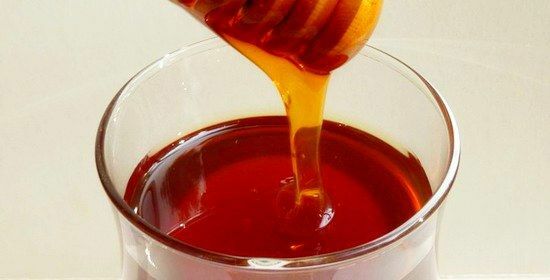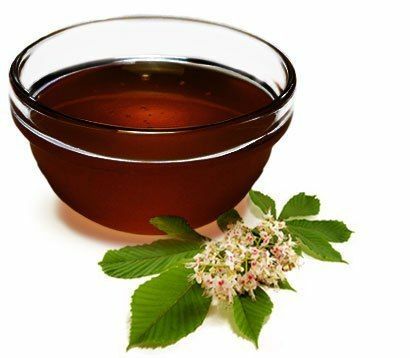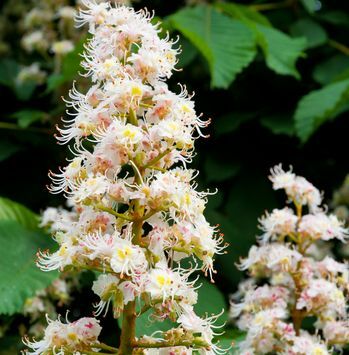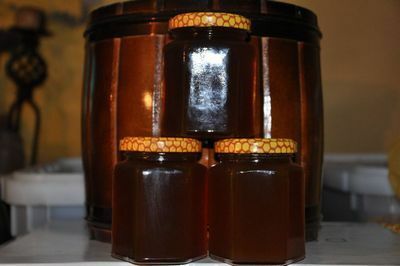 Chestnut honey along with other varieties has a beneficial effect on the human body. Its sources are two kinds of chestnut trees: horse and noble. The first grows along the avenues and sidewalks of many cities and does not eat its fruits, whereas the noble chestnut is perceived by people as a delicious delicacy. Bees collect nectar from both species, giving out two different honey at the output. Chestnut noble gives humanity a dark brown product with a bitter taste and a liquid consistency. With the horse type, honey is colorless and very liquid. More valuable and widespread nectar of noble chestnut.
Chestnut honey along with other varieties has a beneficial effect on the human body. Its sources are two kinds of chestnut trees: horse and noble. The first grows along the avenues and sidewalks of many cities and does not eat its fruits, whereas the noble chestnut is perceived by people as a delicious delicacy. Bees collect nectar from both species, giving out two different honey at the output. Chestnut noble gives humanity a dark brown product with a bitter taste and a liquid consistency. With the horse type, honey is colorless and very liquid. More valuable and widespread nectar of noble chestnut.
Product Characteristics
How to identify chestnut honey
The product can be easily distinguished by a saturated dark brown color. The taste is unsweetened, sharp and bitter, with a predominance of spicy notes. The smell is strong, with barely perceptible shades of chestnut flowers. And the darker the honey, the more tangible the specific flavor.
Warning! The real chestnut honey slowly crystallizes and remains in a liquid state for a long time. Due to the short flowering of the chestnut, the product is obtained in small quantities. Often under his brand are trying to sell buckwheat or any other variety mixed with fried sugar.
Chestnut honey, the taste of which is not respected by sweet tooth, is actively used in cooking to add a special flavor to baking.

Chemical composition of
Chestnut honey can boast of an abundance of micronutrients and useful compounds. It includes salts, manganese, iron, copper, fructose, sucrose and a rich set of vitamins. Sucrose is contained in it in large quantities than in other varieties. Its chemical composition is also unique due to the presence of acetophenone, which gives the product the smell of mimosa and aminoacetophenone, which gives honey a specific aroma.
collection area To find out where chestnut honey is collected, let's look at the places where the chestnut tree grows. It is distinguished by a limited area of growth. This is mainly the southern part of Europe( Italy and France), Asia Minor, the Crimea, the Transcaucasus and North America.
Warning! Chestnut honey is a rare, hard-to-reach product and is very expensive.

15 healing qualities of chestnut honey
- Bactericidal and healing effect. The product fights against colds, sore throats, flu and effectively heals deep wounds, severe burns, bruises and cuts.
- Resolute healing of bronchitis, tonsillitis, asthma and other respiratory tract infections.
- Anti-inflammatory, choleretic and decongestant effect. Increase appetite and relieve stress.
- Cure for the genitourinary system and kidneys.
- Chestnut honey, whose useful properties are almost unlimited, cope better than any preparations with thrombophlebitis and varicose veins. It stabilizes blood pressure and prevents cardiac diseases.
- Effective treatment of the digestive system and alleviation of ulcerative symptoms.
- Regular use of honey contributes to the treatment of the liver.
- The product is an excellent, firming and immunity remedy.
- It positively affects the nervous system and has a calming effect.
- Great is the use of chestnut honey for the developing baby's body.
- Its antibacterial and antiseptic properties are high.
- This kind of honey is a valuable dietary product recommended after severe illness and during the recovery period.
- It favorably affects the mucous membrane of the gastrointestinal tract, promotes digestion of food and speeds up metabolic processes.
- Honey from chestnut invigorates, saturates the person with energy and strength, tones up and activates the protective functions of the body.
- The product gives rise to resistance to stress and depression, it is an effective preventative against many ailments.
Contraindications
Warning! Chestnut honey can bring the body and benefit and harm.
The product is contraindicated in patients with diabetes mellitus, as in it sucrose predominates over fructose. It should be abandoned and people with increased sensitivity to beekeeping products. Otherwise, the likelihood of allergic reactions in the form of a rash, a cold or a stomach disorder is very likely.

How to take chestnut honey
There are a lot of ways of using chestnut honey. The most trivial is to eat every day at breakfast on a teaspoonful. It can be dissolved in warm water or not hot tea, spread on bread or a roll. Residents of European countries use this product in a duet with cheese, yogurt, ice cream and cream desserts. It is universally used in cooking.
Warning! When adding chestnut honey to desserts and pastries, you can not heat it above 60 degrees, otherwise it will lose all of its medicinal qualities.
The sooner the chestnut honey appears in your diet, the more diseases you will be able to avoid. It is important only to remember that you should not get carried away with this product excessively. In any case, it is better not to exceed the daily rate of honey, otherwise there is a risk of harm instead of good.
